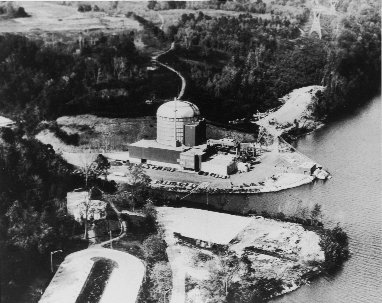How Germany’s Troubled Pebble Bed Reactor Came Of Age In China [Hackaday]

Although the concept of nuclear fission is a simple and straightforward one, the many choices for fuel types, fuel design, reactor configurations, coolant types, neutron moderator or reflector types, etc. make that nuclear fission reactors have blossomed into a wide range of reactor designs, each with their own advantages and disadvantages. The story of the pebble bed reactor (PBR) is among the most interesting here, with its development winding its way from the US Manhattan Project over the Atlantic to Germany’s nuclear power industry during the 1960s, before finding a welcoming home in China’s rapidly growing nuclear power industry.
As a reactor design, PBRs do not use fuel rods like most other nuclear reactors, but rather spherical fuel elements (‘pebbles’) that are inserted at the top of the reactor vessel and extracted at the bottom, allowing for continuous refueling, while helium acts as coolant. With a strong negative temperature coefficient, the design should be extremely safe, while providing high-temperature steam that can be used for applications that otherwise require a coal boiler or gas turbine.
With China recently having put its twin-PBR HTR-PM plant into commercial operation, why is it that it was not the US, Germany or South Africa to first commercialize PBRs, but relative newcomer China?
Flow Of The Pebbles

The idea of a high-temperature, gas-cooled reactor and the PBR in particular was first coined by Farrington Daniels, a physical chemist by training, which led to the first of such a unit being built in the US as Unit 1 of the Peach Bottom nuclear power plant. With the concept of the High-Temperature Gas-cooled Reactor (HTGR) taking hold, the UK built a somewhat similar design in the form of the Dragon reactor, though the Peach Bottom unit was the first to produce electricity.
All of these HTGRs have in common that they use graphite as the neutron moderator, with helium as the coolant. Graphite is highly temperature resistant, and helium is an inert gas that will not undergo chemical reactions with other materials or substances. Additionally, helium is not susceptible to neutron capture and will thus not become radioactive over time. These operating parameters is where the ‘high-temperature’ part of the design comes from, as the reactor core can run at much higher temperatures.

Whereas a typical pressurized light-water reactor (PWR) will have a reactor coolant inlet temperature of around 290°C and an outlet temperature of below 350°C, an HTGR’s inlet temperature is around 250°C, with around 750°C on the outlet. This puts it at or above the level of a standard coal-fired thermal plant’s steam temperature, and strongly increases its thermal efficiency over that of light- and heavy-water reactors. The US’s second HTGR (Fort Saint Vrain, in Colorado) was operational from 1979 to 1989 (one year past Peach Bottom Unit 1), but it being the first-of-a-kind (FOAK) of a commercial HTGR meant that many design issues were being ironed out during commercial operation, which eventually played a big role in its shutdown, and ultimately its conversion to a natural gas plant by 1996, as the US continued its general turn back to fossil fuels from nuclear power.
Beyond these two HTGRs, the UHTREX experimental reactor (1959 – 1971) at Los Alamos National Laboratory was also constructed, but used for testing fuel types rather than electricity production. This testing included direct cooling of the fuel without cladding, which enabled much higher burn-up as the fission products were able to move into the coolant flow.
With the shutdown of Fort Saint Vrain’s HTGR, the era of this reactor type in North America came to an end.
German Engineering Chops
Although the US and UK HTGRs used essentially fuel rods not unlike their water-cooled brethren, in Germany Rudolf Schulten – a professor at RWTH Aachen University – took it upon himself to develop a version using spherical fuel elements. This led to the world’s first PBR being built in the form of the Arbeitsgemeinschaft Versuchsreaktor, or AVR. As the world’s first ever PBR prototype, it suffered a number of issues after its commissioning in 1967, like helium leakage. Other issues were discovered after its shutdown in 1967, in the form of pebbles stuck in the bottom graphite neutron reflector, and a fine graphite dust contaminated with fission products, the latter of which was traced down to the high reactor temperature of 950°C not working well with the bi-isotropic (BISO, two layers of pyrocarbon) coated fuel particles that caused contamination with radioactive isotopes.

Years later, the prototype THTR-300 PBR was constructed, with commissioning in 1985. This used many of the lessons learned from the AVR, such as running the reactor at a lower temperature for an outlet temperature of 750°C and using TRISO (tri-isotropic with silicon carbon layer) coated fuel particles that are good up to about 1800°C. This reactor was however shut down in 1988 due to the growing anti-nuclear sentiment in Germany, which also affected what would have been the next step in the form of the modular ‘HTR-Module‘ (PDF) design developed by Siemens/Interatom. This modular design involves multiple reactor cores that are connected to a single steam generator, which eases scaling of the reactor total power.
When the HTR-Module project looked to be non-viable in Germany due to the societal resistance, a partnership with countries like China was established, with the Chinese HTR-10 PBR starting construction in 1995. Much of the mainstream resistance against nuclear power in Germany can be traced back to the 1986 disaster at the Chornobyl nuclear power plant (ChNPP), which led to fear-filled writings like ‘Die Wolke‘ (The Cloud, translated as ‘Fall-Out’), which is a book that became required reading for Germany’s youth in which the effects of even a Chernobyl-style disaster are massively exaggerated.
The irony is perhaps that in a country which adores soaking in radioactive radon spas and radioactive water, the effects of the ChNPP disaster would be thus exaggerated, despite this disaster causing a few dozen deaths for those near the destroyed RBMK reactor core, no appreciable increase in cancers and no genetic effects being passed down to one’s offspring. Yet because fear speaks louder than evidence, Germany’s PBR technology died in Europe, met resistance in South Africa and found a warm embrace in China, a nation which saw itself faced with a rapidly growing population and associated power demands.
Enter The Dragon

Nuclear power has been a core tenet of China’s energy policy since the 20th century, with HTGR designs being one of the many puzzle pieces needed to make things work. Alongside many foreign light- and heavy-water designs ranging from US AP1000s and Soviet/Russian VVERs to Canadian CANDU PHWRs, China sought to gain experience with as many reactor designs as possible, to incorporate this into new designs for use in the Chinese market, as well as for its exports. With the HTR-10 acting as China’s first PBR design, it would prove the stepping stone for following prototypes.
Today, HTR-10 is still online, after having been commissioned in 2000 and serving as a testbed for many aspects of the design, including various safety tests (alternative link) such as the complete loss of forced cooling, which is one aspect where the reactor’s negative temperature reactivity and TRISO fuel should prevent any accidents. The next Chinese PBR became the HTR-PM, where the ‘-PM’ stands for ‘pebble-bed module’, and which implements the HTR-Module concept for the first time with two 100 MWe (250 MWth each) cores. After construction began in 2012, it was commissioned in 2021, reached full power in 2022 and commenced commercial operations in December of 2023.
With the successful operation of its second PBR, the logical next step with such a HTR-Module-based plant will be to ramp up the number of modules to 6, which will be done with the aptly-named HTR-PM600. Its design is unchanged from the HTR-PM, just with more modules to increase the thermal power, with as design goal to make it fully compatible with the steam generators in existing (Chinese) coal plants. Since coal boilers operate at much higher temperatures than conventional water-based nuclear fission reactors, this was not possible before.
Currently there are 3,092 coal-fired plants operating in China, many of which could likely have their boilers replaced with HTR-PM600 PBRs while retaining the rest of the infrastructure. Along with applications in the (petro)chemical and other industries where high temperatures are needed, the HTR-PM600 as well as other HTR-PM configurations could be used instead, while providing flexibility in terms of load-following, and the used fuel, with thorium also being an option; a resource that China has significantly more of than uranium in its soil.
High-Temperature Future
At this point in time, China is the only nation in the world with commercial HTGRs in operation, as well as the only nation to run PBRs. Japan has been running its own HTGR called the HTTR since 1999, which is of an HTGR design with fuel rods that’s more closely related to the US’s HTGRs. It resumed operation in August of 2021 and is considered an important testbed for its own HTGR ambitions.
Whether PBRs or other HTGRs will make their way back to Europe or the US any time soon is uncertain, although US start-ups like X-energy with its Xe-100 PBR are looking to make it in the commercial market. The bright side for such start-ups is probably that a lot of the hard R&D work has been done by now, with general design aspects and fuel design less of a complete guess like in the 1960s. Going from there to a competitive design and finding the right target market still remains a major challenge, one which probably has many players looking at China as its modular PBR tries to establish itself first in the green pastures of the Chinese market.

![how-germany’s-troubled-pebble-bed-reactor-came-of-age-in-china-[hackaday]](https://i0.wp.com/upmytech.com/wp-content/uploads/2023/12/157987-how-germanys-troubled-pebble-bed-reactor-came-of-age-in-china-hackaday-scaled.jpg?resize=800%2C445&ssl=1)